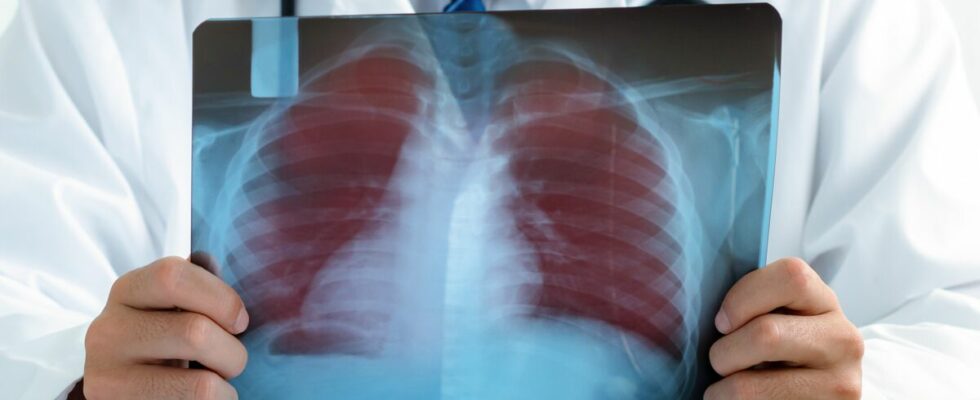Leading cause of cancer death in France and worldwide, lung cancer has affected more than 52,000 people in 2023 in France. If its incidence and mortality tend to decrease in men, it continues to increase in women. “Variations which can be explained in particular by the gap between the evolution of practices – reduction in male smoking and increase in female smoking – and the appearance of cancers linked to these consumptions, 20 to 30 years later”specifies Professor Nicolas Girard, pulmonologist.
Non-small cell lung cancer: what are we talking about?
There are two main types of lung cancer:
- THE non-small cell lung cancers (NSCLC) which represent 80 to 85% of lung cancers;
- and the small cell lung cancers (CBPC) which are closely linked to tobacco consumption (15% of lung cancers)
Non-small cell lung cancer is a cancer that develops from the cells of the bronchi (squamous cell carcinomas) or the cells that line the alveoli of the lungs (adenocarcinomas).
What are the symptoms of non-small cell lung cancer?
Lung cancer can manifest itself with the following symptoms:
- shortness of breath, difficulty breathing;
- cough;
- long-lasting bronchitis or even recurrent pneumonia;
- bloody sputum.
But, most often, it is the manifestations linked to the spread of the disease (metastases) which are at the origin of its discovery. For example :
- pain in the chest wall or shoulder;
- headaches ;
- swelling of the face, neck and hollows above the collarbones;
- discomfort or blockage when swallowing.
“Most patients do not have symptoms, which explains why 60 to 70% of patients are diagnosed at an advanced stage.confirms Professor Nicolas Girard. It is the discovery of metastases which will reveal the disease. Hence the interest in setting up organized screening. As lung cancer has an asymptomatic or minimally symptomatic phase, screening would allow it to be detected earlier.”
Unlike breast cancer, there is currently no organized screening for lung cancer in France. “This could be implemented by 2030 and would be aimed at smokers over the age of 50 or who have smoked for over twenty-five years”, continues the pulmonologist. Objective: detect the disease at an early stage, when it is operable, and increase the chances of survival of patients.
What are the risk factors?
Smoking is the number 1 risk factor. “Nearly 80% of lung cancers are linked to tobacco”, recalls Professor Girard. In addition to tobacco consumption, certain environmental factors – for example occupational exposure to carcinogenic products such as asbestos, arsenic, nickel or chromium – would also favor its development.
Non-small cell lung cancer: how is it diagnosed?
Several examinations are necessary to confirm the diagnosis of lung cancer and to assess the extent of the disease. “If the radiological examinations are suggestive of lung cancer, we will take a biopsy of the lesionindicates the specialist. Biopsies are carried out either by bronchoscopy – a small tube is inserted into the patient’s nose or mouth and descended into the lung to reach the lesion and take the sample – or by percutaneous puncture through the skin. This helps confirm the diagnosis, identify the type of lung cancer (small cell or non-small cell) and look for biomarkers to determine treatment.”
In parallel, an expansion report (PET-Scan, brain MRI, etc.) will allow us to check whether the disease is localized to the lung or whether it has spread. According to the Institut Curie, following this assessment, lung cancer is classified into four stages:
- stage I : localized cancer whose size is less than or equal to 4 cm, without regional lymph node involvement and without metastases;
- stage II : localized cancer whose size is greater than 5 cm and/or which presents intrapulmonary lymph node involvement, without regional lymph node involvement and without metastases;
- stage III : locally advanced cancer due to mediastinal lymph node involvement and/or invasion of the mediastinum or chest wall
- stage IV : cancer associated with at least one metastasis.
What are the treatments ?
Surgery remains the treatment of choice in stage 1 and 2 (or even stage 3) cancers in combination with chemotherapy and radiotherapy. “Today’s use of targeted treatments and immunotherapy before or after surgery significantly reduces the risk of relapseexplains Professor Girard. Immunotherapy is rather used before surgical intervention and will stimulate the patient’s immune defenses so that they destroy the cancer cells themselves. In a quarter of patients, immunotherapy makes the cancer disappear and has a vaccination effect which protects them from a relapse.”
The treatment of stage 3 lung cancer where the tumor is not operable is based on chemotherapy, radiotherapy and immunotherapy.
Finally, in the most advanced forms of cancer (stage 4), treatment combines chemotherapy, immunotherapy and targeted therapies. “When we identify certain molecular abnormalities in the genes of the tumor, we use targeted therapies to make it regress, concludes the specialist. Patients who do not have this anomaly will be treated with immunotherapy combined with chemotherapy.”
